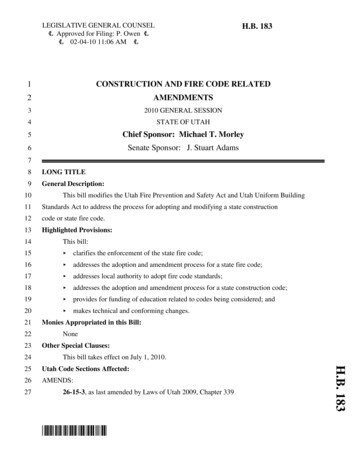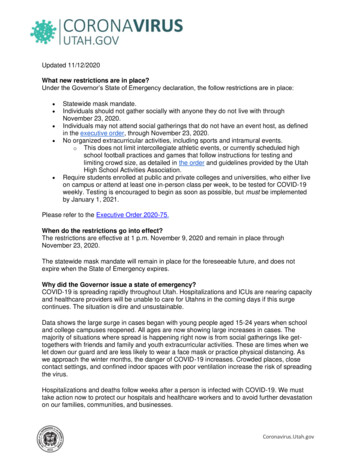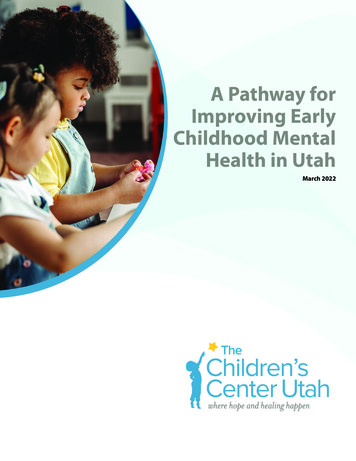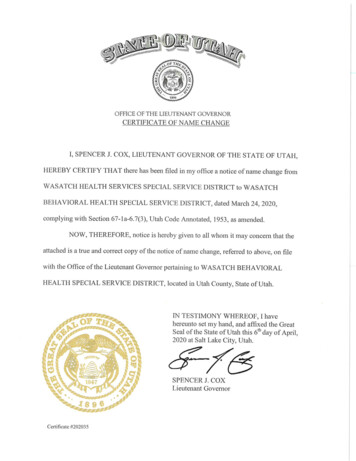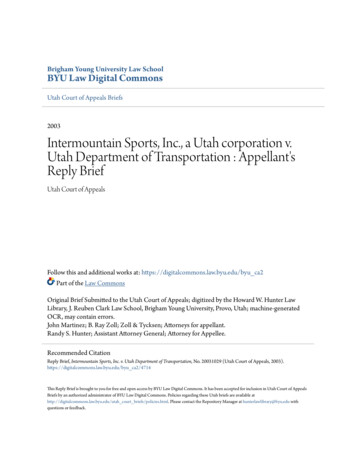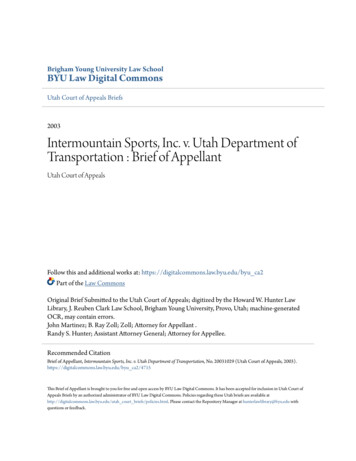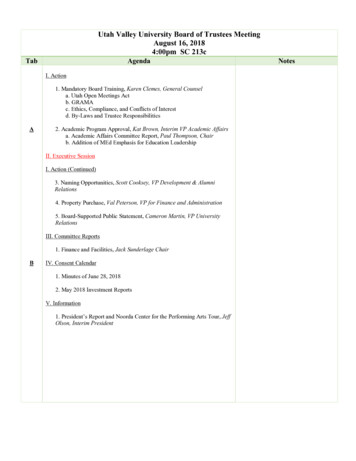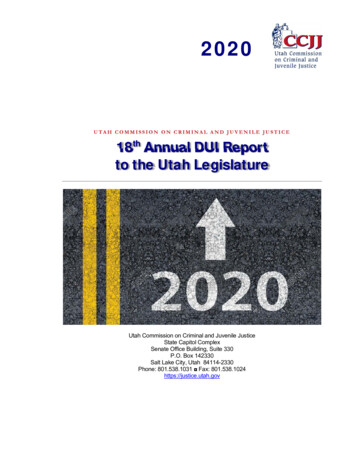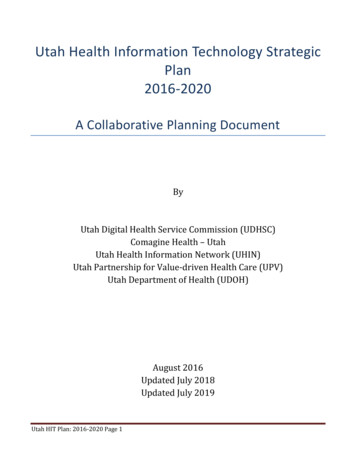
Transcription
Utah Health Information Technology StrategicPlan2016-2020A Collaborative Planning DocumentByUtah Digital Health Service Commission (UDHSC)Comagine Health – UtahUtah Health Information Network (UHIN)Utah Partnership for Value-driven Health Care (UPV)Utah Department of Health (UDOH)August 2016Updated July 2018Updated July 2019Utah HIT Plan: 2016-2020 Page 1
Health and Health Information Technology (IT) VisionsOur statewide health vision is for Utah to be a place where all people can enjoy the best health possible,where all can live and thrive in healthy and safe communities. https://health.utah.gov/Our statewide vision for health IT is for Utah to be a place where the secure and efficient use andexchange of electronic health information will result in improved health status, better health care, lowercost and healthier communities.Health IT Guiding PrinciplesUtah has made significant progress in adoption electronic health records (EHR) and clinical healthinformation exchanges (HIE) since 2005. In 2016-2020, Utah will move forward under following guidingprinciples: Continue to foster statewide collaboration with all partnersLeverage the market and existing HIT infrastructuresEncourage interoperability and portability across care settings through multi-level or modularadvancementsProtect privacy and security in all aspects of IT and its usesEnhance consumer engagementShare meaningful health information among learning health systems to ensure innovation, quality,safety and value in health care.Using health IT to strengthen health of individuals, families, communities and add value to Utah’seconomy.State HIT Plan History 2013 – State Innovation Model Grant funded planning for statewide IT initiatives. Commission’schair co-chaired these efforts2015 – Commission updated the Utah Health IT Vision, Principles and Priorities2016 – the Commission led the developed and oversight of the first Utah’s Health IT Strategic Plan(2016-2020) as well as Performance measures2017 – Updated State HIT plan to align with ONC National HIT Strategic Plan2018 – Updated plan with current and potential projects and established goal review andmeasurement dashboard cycle.o January - Goal deep diveo March – Review dashboard and plan changeso May – Goal deep diveo July - Vote on plan changes, Goal deep diveo August – UDOH presents HIT plan to Medicaid for inclusion in Medicaid updateso September – Review dashboardo November - Goal deep dive2019-Reviewed each goal, objective, and projectUtah HIT Plan: 2016-2020 Page 2
Priority Framework for Health ITUtah health IT priority is to improve system interoperability and portability to support integration ofphysical and behavioral health care and improve population health for all Utahans.The Priority Framework of Health IT for Population Health and a Statewide Learning Health System inUtah (See Figure 1) describes the relationship of various health IT components, health data uses andstatewide initiatives as follows: The left pyramid includes core IT applications that were identified in our statewide IT architecturedesign for 2009-2014 efforts.The Health IT systems provide information services for multi-level information uses ranging fromcare provided in medical home, neighborhood and communities to patient registries, value-basedhealth systems, as well as public transparency reporting (the right pyramid).Interoperability and portability are key functions among all IT applications and infrastructure,services, and connections to health data users.Health IT must support an integrated collaborative learning health system.Health IT must improve efficiency of health promotion and enhance health IT literacy and training.EducationMembers of the Digital Health Service Commission will consider a process to help inform and betterprepare both the public and health care providers on how to more fully access and use these resources thatresult from the plan projects.Utah HIT Plan: 2016-2020 Page 3
Utah Health IT Status:Below is summary information on Utah statewide health IT performance in comparison with the nationalaverage. The data source for these indicators is from the web site of U.S. Department of Health and HumanService National Office of Coordinator for Health IT at http://healthit.gov.Utah Health IT Status and Alignment with the Office of the National Coordinator in 2018The national direction for Health Information Technology advances interoperability and encouragesprovider connectivity with others as a core metric in the 2018 CMS Quality Payment Program (QPP).“Promoting Interoperability (PI)” focuses on “interoperability, improving flexibility, relieving burden”. lity.As of Summer 2018 the initial submissions to the QPP by providers for 2017 are final and we anticipatehigh-level if not state by state benchmarks on participation. This document will be updated as nationalbenchmarks occur to further inform Utah’s participation and any gaps that may be addressed by the StateHIT plan.Utah HIT Plan: 2016-2020 Page 4
Utah Health IT SummaryThis table shows how Utah compares to the national average on measures of HIT adoption and utilizationthat have been updated within the past two years. Data was obtained from the Office of the NationalCoordinator ation-technology-data-summaries.php).While Utah appears to be performing well regarding hospital adoption of health IT, office physicianadoption of health IT appears to be lagging.Utah Health IT SummaryDomainEHR AdoptionsCertified IT VendorsElectronic PrescribingExchange & InteroperabilityHITECH ProgramsPatient EngagementPublic Health reAdopted Certified EHRsAdopted Any EHRsAdopted Certified EHRsHospitalsReported Certified Health IT Vendor(2014)ProfessionalsReported Certified Health IT Vendor(2014)No recent dataElectronically Send from Outside HealthHospitalsProvidersElectronically Receive from Outside HealthHospitalsProvidersElectronically Find from Outside HealthHospitalsProvidersElectronically Integrate from Outside HealthHospitalsProvidersAll Domains Electronically from OutsideHospitalsHealth ProvidersElectronically Send from Outside HealthPhysicians ProvidersElectronically Receive from Outside HealthPhysicians ProvidersElectronically Find from Outside HealthPhysicians ProvidersElectronically Integrate from Outside HealthPhysicians ProvidersElectronically Send or Receive from AnyPhysicians Health ProviderElectronically Send from Any HealthPhysicians ProviderElectronically Receive from Any HealthPhysicians ProviderNo recent dataProvided Electronic Capabilities to PatientsHospitalsAPI AccessProvided Electronic Capabilities to PatientsPhysicians Secure MessagingNo recent dataUtah HIT Plan: 2016-2020 Page 5YearRecentNatl Avg UtahCompare201796%97% 201786%94% 201780%85% 201796%95% 201781%71% 201788%91% 201774%82% 201761%84% 201753%79% 201741%75% 201736%25% 201738%31% 201753%49% 201728%22% 201746%43% 201736%25% 201738%31% 201738%54% 201768%65%
Utah Health IT Strategic Goals and Objectives in 2016 - 2020:GOAL 1: ADVANCE THE HEALTH AND WELL-BEING OF INDIVIDUALS AND COMMUNITIES THROUGHPERSON-CENTERED AND SELF-MANAGED HEALTHOBJECTIVES:1A. Increase use of individual health information for engagement and shared decision making as part of theteam – Enable individuals to understand and act upon available cost and quality information1B. Advance individuals’ abilities to “access, control and amend” their health information1C. Increase adoption and use of patient portals and consumer-focused HIT1D. Promote patient education and use of HIT tools for wellness and self-care1E. Increase effective patient/consumer-mediated and generated exchange1F. Advance individual’s access to and appropriate sharing of public health dataGOAL 2: STRENGTHEN HEALTH CARE DELIVERY TRANSFORMATIONOBJECTIVES:2A. Increase HIT functions to support transparency of and access to quality and cost information at thecommunity and provider level to improve care2B. Increase implementation of HIT functions to support innovative models of care that promote highvalue health care – Medical Home, ACOs, Telehealth2C. Increase use of electronic quality improvement tools and measurements that support provideradherence to evidence-based guidelines, improved outcomes and reduced waste2D. Support the use of health IT to help providers and communities to better serve high-risk individualsand populationsGOAL 3: ENHANCE UTAH'S INTEROPERABLE HEALTH IT INFRASTRUCTUREOBJECTIVES:3A. Endorse basic guidelines for HIT standards that align with and strengthen national certificationrequirements, including interoperability, to increase effective health information exchange3B. Protect privacy and security of electronic health information by increasing adherence to federalelectronic health information security guidelines in independent facilities and practices3C. Increase functionality and effectiveness of state-wide HIE (CHIE) and support increased connectionswith other data sources including integrated delivery systems (IDS), HIEs, and providers.3D. Increase ability to exchange public health information with providers through various exchangemethods to improve population health3E. Develop governance, access, and support for health data to be made available for analysis and use3F. Increase Utah’s influence on the national forums related to effective delivery of care through HIT3G. DHSC will attend conferences to promote interoperability work.GOAL 4: SUPPORT INNOVATION AND APPLIED RESEARCH TO EFFICIENTLY IMPLEMENT STATEWIDEHEALTH IT INITIATIVESOBJECTIVES:4A. Promote collaborative innovation and research to advance implementation, utilization andimprovement of health IT in public, private and academic settings4B. Broaden statewide partnership and engagement in implementing the Utah HIT strategic plan4C. Disseminate evidence-based best practices to enhance statewide adoption of technology solutionsUtah HIT Plan: 2016-2020 Page 6
Definitions of ACTIONS:Expansion- A project currently implemented but needing to expand to a larger audience or expandservices.Gap- No identified state level activities.Implementation- A project that has designated resources and defined scope and is in progress.Needs resources- A project that has been either planned and/or implemented but needs additionalresources to move forward.Planning- A project in concept development but lacks resources to advance to implementation orexpansion status.Descriptions of Projects/Strategies:PROJECTS FOCUSED ON PATIENT KNOWLEDGE AND INVOLVEMENT APCD (Price Transparency) & NRHI Total Cost of CareAction: ImplementationPrimary: UDOH- OHCS, Comagine HealthGoals/Objectives Supported: 1A, 2ATo increase transparency reporting on healthcare quality and cost using the All Payer ClaimsData or Total Cost of Care Data. (Baseline online report 2; Baseline online query tool 2) UtahHealthScape.org (Transparency for Consumers)Action: ImplementationPrimary: Comagine Health, UDOH-OHCSGoals/Objectives Supported: 1A, 2AUtahHealthScape.org provides health care consumerswith resources to support informed decision-making. UtahHealthScape provides a directory ofproviders and clinics and quality ratings for hospitals, health plans, nursing homes, and homehealth agencies, along with other valuable information. Comagine Health's Patient & Family Advisory Council and state-wide PFAC ConsortiumAction: ExpansionPrimary: Comagine HealthGoals/Objectives Supported: 1A, 1CComagine Health's Patient & Family Advisory Council (PFAC) helps us better understand thehealth care system from the patient's viewpoint. Patients, families and caregivers participatingin the PFAC share their personal stories and health care experiences. This patient input isimportant in influencing how we design our projects to make our health care system better. Webelieve that patient wisdom is a "must have" factor in improving health care. Comagine Healthconvenes patient and family advisories throughout the state and HIT is a topic of interest,specifically Open Notes and portal use, for engagement and efficiency of care. ePOLST Analysis and ImplementationAction: Planning/Needs ResourcesPrimary: UDOH, UHINGoals/Objectives Supported: 1A, 1B, 1CStarted: 10/2017Consensus built stakeholder recommendations on how to move forward in establishing anePOLST registry, supporting the registry and implementing it throughout the state. Planning project for 1D - Promote patient use of HITAction: GapPrimary: UDOHUtah HIT Plan: 2016-2020 Page 7
Goals/Objectives Supported: 1DRecognize gap. No current activity at this time. Planning project for 1E - Consumer-mediated/generated exchangeAction: ExpansionPrimary: UHINGoals/Objectives Supported: 1EStarted: 11/2015CHIE has a limited pilot on the patient portal with planned expansion. CHIE Patient PortalAction: ExpansionPrimary: UHINGoals/Objectives Supported: 1A, 1B, 2CStarted: 11/2015This is an ONC grant item that created a patient portal that has access to the CHIE and allows forpatient to share information with their provider. Planning to add ePOLST and Pediatric CareSummary data for patient access. Future roadmap items include benefit information,immunizations and care plans. Open Notes CampaignAction: ExpansionPrimary: UPV-Comagine Health, UHIN, UHIMSSGoals/Objectives Supported: 1A, 1B, 1C, 1E, 3CStarted: 11/2017Open Notes is a movement that urges doctors, nurses, therapists, and others to invite patientsto read the notes they write to describe a visit through sharing from an electronic health recordportal. Utah has a number of systems using electronic health records that can make notesavailable. Initiatives to increase patient awareness and use can impact patient safety as well astrust between providers and patients. Goal is to increase participants in the Open NotesInitiative.Patient ConsentAction: PlanningPrimary: UHINGoals/Objectives Supported: 1A, 1C, 1E, 2B, 3CStarted: 9/2011Develop patient consent tools for consent designation for sharing information across HIPAAand non-HIPAA providers. Utah Department of Technology Services Digital Citizen Integration Project.Action: PlanningPrimary: DTSGoals/Objectives Supported: 1A, 1C, 1FDevelop single sign on for citizens to access state services and records related to them. Resultof SB 137 (2019)PROJECTS FOCUES ON HEALTH CARE DELIVERY TRANSFORMATION Provide Support for Quality Reporting (PQRS, MU, MACRA)Action: ImplementationPrimary: Comagine Health and UHINGoals/Objectives Supported: 1C, 1A, 2BStarted: 1/2009Utah HIT Plan: 2016-2020 Page 8
Comagine Health gives quality improvement support to Utah physician offices and hospitals onreporting and improving quality measures. Specific emphasis on the Quality Payment Program(QPP), Accountable Care Organizations (ACOs), other Alternative Payment Models (APMs),behavioral health care and Ambulatory Surgical Center care are a focus for improvement effortsand improving outcomes. UHIN is working with providers to meet Promoting Interoperability(previously Meaningful Use) requirements and assist with criteria for QPP and is evaluatingwhether to assist members with reporting. GetHealthyUtah.org (Population Health)Action: ImplementationPrimary: Utah Leaders for HealthGoals/Objectives Supported: 2B, 2C, 2DTo improve the health of all Utahns by supporting healthy eating and active living in order toassociated health consequences. Death NotificationsAction: ExpansionPrimary: UDOHGoals/Objectives Supported: 2B, 2DTo develop timely notifications of deceased patients or members to providers and payers forthem to improve their population health data. Long-Term/Post-Acute Care Summary ExchangeAction: ExpansionPrimary: UHINGoals/Objectives Supported: 2B, 3CStarted: 11/2015This is an ONC project intended to exchange CCD documents between hospital and long termcare providers. The pilot effort included Avalon and Intermountain Healthcare. The expansioneffort is to include all LTCs and Hospitals. Dashboards (HIT, NQF, Monarch) for Geographic Quality AnalysisAction: ExpansionPrimary: UHIN, UDOHGoals/Objectives Supported: 2C, 2DStarted: 12/2015This project intends to provide hot spotting to providers for their patient panels and for publichealth reporting. There are currently 36 measures contained in the system. Adult Immunizations - increase rates (flu, pneumonia)Action: ImplementationPrimary: Comagine Health, UDOH-USIISGoals/Objectives Supported: 2CWorking with organizations to help improve the assessment and documentation of Medicarebeneficiaries’ immunization status, increase overall immunization rates and reduceimmunization disparities. Comagine Health's Quality Awards ProgramAction: ExpansionPrimary: Comagine HealthGoals/Objectives Supported: 2B, 2CThe Comagine Health Quality Award Program was launched in 2004 to promote high qualityand transparency in health care. Yearly awards are given to Utah health care providerorganizations based on standardized criteria (including Health IT) in the following areas: Home HealthUtah HIT Plan: 2016-2020 Page 9
Hospital Nursing Home Physician Office ADT Alerts for reducing admissions and readmissionAction: ExpansionPrimary: UHINGoals/Objectives Supported: 2B, 2D, 3CStarted: 9/2013Encounter Notification Services for the community and pushing those to different endpoints torural and out of state providers. Clinical information exchange among public health, EHRs, and HIEAction: ExpansionPrimary: UDOH-DCP, UHINGoals/Objectives Supported: 2A, 2C, 3DStarted: 1/2009To expand clinical data exchanges between HIE, EHRs and public health programs to supportpopulation health improvements (Baseline on operational use cases 3, Immunization, EHR,and Syndromic Surveillance). Expanding to Newborn Screening and planning for cancerregistry. Obesity & Diabetes Population HealthAction: ImplementationPrimary: UDOH, UHINGoals/Objectives Supported: 2B, 2C, 2DStarted: 12/2015Baseline measures of obesity and diabetes using clinical data stream are obtained from theCHIE. COB Database - Payer coordinationAction: PlanningPrimary: UHINGoals/Objectives Supported: 2AcStarted: 1/2014Working with community payers to improve the Coordination of Benefits. Updating Processwith new APCD Vendor Fall Prevention InitiativeAction: Planning/Needs ResourcesPrimary: UDOH, UHINGoals/Objectives Supported: 2B, 2D, 3CStarted: 9/2017This initiative is based on legislative interest. It is to explore using EMS data to identify and alertproviders/Aging Services on patients with the potential for falls so that they can follow up. Thisproject also entails exploring ability to share information with social services agencies. Shared Care PlanAction: PlanningPrimary: UDOH, UHIN, UHPPGoals/Objectives Supported: 2B, 2D, 3CStarted: 10/2017Utah HIT Plan: 2016-2020 Page 10
This project is to enable sharing of care plans across disparate providers to enhance carecoordination. This includes behavioral health care plans and referrals for vulnerablepopulations. Home Health HubAction: Planning/Needs ResourcesPrimary: UDOH, UHINGoals/Objectives Supported: 2B, 2D, 3CStarted: 2/2018Using HIT for Home Health Orders to increase timeliness of care. Would allow for electronicsignatures on orders. Social Service Referrals – Addressing social determinants in healthcareAction: PlanningPrimary: UDOH, UHIN, United WayGoals/Objectives Supported: 2B, 2D, 3CStarted: 9/2018Have assessments in primary care and developing the ability of primary care to refer to 211 andthen having the referral report back to the provider through the CHIE. Pharmacy integration medication reconciliationAction: PlanningPrimary: UHIN, Comagine HealthGoals/Objectives Supported: 2B, 2D, 3CStarted: 1/2009Integrating pharmacy data into the CHIE for medication reconciliation of non-controlledsubstance medication. State telehealth capacity for primary care and public health service delivery –Action: planningPrimary: UDOH EPICC and MCHGoals/Objectives Supported: 2DAssess capacity and needed development for delivery of health care services via telehealth,focused on primary care at this time. UDOH EPICC's workplan activities include workingtowards establishing and expanding the use of telehealth technology to increase access toDSMES programs. Additionally staff are working with LHDs to conduct an inventory of currentproviders using telehealth mechanisms to provide DSMES and/or diabetes education servicesand explore systems/software and equipment necessary for providing DSMES telehealthservices. UDOH MCHHas a telemental health pilot contract with the University of Utah that will be extended withsome legislative funding. UDOH also has a statewide safety bundle initiative that is beingimplemented through Project ECHOPROJECTS FOCUSED ON ENHANCING UTAH'S INTEROPERABLE HEALTH IT INFRASTRUCTURE Rural Community Connectivity to CHIEAction: ImplementationPrimary: UHINGoals/Objectives Supported: 2B, 2D, 3CStarted: 1/2009Increase usage and participation in the CHIE. There has been much progress on this. There arefour rural hospitals that still need to connect.Utah HIT Plan: 2016-2020 Page 11
Bi-directional Immunization Query through CHIEAction: ImplementationPrimary: UHIN, UDOH-USIISGoals/Objectives Supported: 3C, 3DStarted: 1/2009CHIE and the Utah Statewide Immunization Information System (USIIS) will develop a bidirectional immunization query through CHIE for CHIE providers to query USIIS for patientimmunization histories. EMS Integration exchange with CHIEAction: ImplementationPrimary: UHINGoals/Objectives Supported: 3CStarted: 11/2015Create an interface for EMS providers to query for information from their patients. Patient Centered Data Home - Multi-HIE ConnectionsAction: ImplementationPrimary: UHINGoals/Objectives Supported: 3CStarted: 1/2016In production with 16 states including Alabama, Arizona, Arkansas, California,Colorado, Idaho, Indiana, Kentucky, Michigan, Nebraska, Nevada, Ohio, Oklahoma,Oregon, Tennessee, and Washington. In process with 5 additional states includingAlaska, Iowa, Louisiana, North Dakota, and Texas. Poison Control Center Data IntegrationAction: ImplementationPrimary: UHIN, UDOHGoals/Objectives Supported: 3CStarted: 11/2015This is to get records in the hands of poison control to facilitate continuity of care. This projectwill work towards all referred hospitals receiving intake information gathered from the PoisonControl center as well as follow up information sent back to the Poison Control Center fortraining and quality assessment. This is an expanded project from the initial work with St.Marks and Intermountain. The Shared Identity Services for Utahns (ThSisU) / Statewide MPIAction: ImplementationPrimary: UDOH, Comagine Health, UHIN, IntermountainGoals/Objectives Supported: 1E, 3A, 3D, 3EStarted: 7/2015To develop a statewide and community-based identity validation services for improving qualityof health services and reducing abuse, misuses, and cost. (Baseline 0) EHR, HIE connections to the Controlled Substance DatabaseAction: ImplementationPrimary: DOPL, UDOH, UHINGoals/Objectives Supported: 3B, 3C, 3DStarted: 11/2017To develop connectivity among the Utah Controlled Substance Database (CSD) with EHRs, theCHIE, pharmacies to increase and improve the uses of CSD for reducing the opioids overdoesprescriptions and deaths. (Baseline 0)Utah HIT Plan: 2016-2020 Page 12
UHIN HIT ConferenceAction: ImplementationPrimary: UHINGoals/Objectives Supported: 2D, 3A, 3B, 3F, 4AStarted: 11/2017Annual educational community- based conference. CHIE AdoptionAction: ExpansionPrimary: UHINGoals/Objectives Supported: 2B, 3CStarted: 1/2009Increase the usage and participation in the CHIE. CHIE ConnectionsAction: ExpansionPrimary: UHIN, UDOHGoals/Objectives Supported: 3CStarted: 11/2015Improved CHIE with behavioral health providers, SNF Home Health and EMS. Statewide Stroke and Cardiac RegistriesAction: PlanningPrimary: UHIN, UDOH, Health InsightGoals/Objectives Supported: 3C, 3DStarted: 1/2018These new registries are required by recent legislation. UDOH is exploring utilizing UHIN toreceive hospital reporting to the statewide stroke and cardiac registries through CHIE. Statewide Standards for Data QualityAction: PlanningPrimary: UHIN, UDOH, Health Insight, ThSisUGoals/Objectives Supported: 2A, 3A, 3E, 4AStarted: 1/2009Establish and implement standards for health data exchanges, building on ONC’s standards.Deploy tools to clean data for analytics. HIE for Newborn Screenings and Follow upAction: ImplementationPrimary: UDOH, UHINGoals/Objectives Supported: 1A, 2BStarted: 11/2015To develop capacity to exchange newborn screening results and follow-up diagnostic reportsbetween public health and providers via CHIE (Baseline 0). Physical and Behavioral Health Interoperability (electronic exchange - PCP to BHand BH to PCP)Action: ExpansionPrimary: UHINGoals/Objectives Supported: 1A, 2BStarted: 8/2016This project intends to exchange needed healthcare information between behavioralhealth and physical health providers. As of August 2016, UHIN is working with pediatricgroups at Granger and the University Neuropsychiatric Institute. UHIN is piloting theupdated SAMHSA consent with adult groups at Davis Behavioral Health.Utah HIT Plan: 2016-2020 Page 13
Use of EHR and/or PCORnet data for chronic disease surveillance by pubic healthAction: PlanningPrimary: UDOH-DCP, CHDI, UHIN Intermountain,University of UtahGoals/Objectives Supported: 2c, 3D, 3EStarted: 6/2018The Bureau of Health Promotion within DCP has been evaluating the efficacy of EHR data forchronic disease surveillance and informing public health intervention and prevention efforts.The plan is to evaluate the PCORnet Common Data Model as a potential data model for statewidechronic disease surveillance, specifically hypertension and diabetes. UDOH collaborates with theIntermountain and the University of Utah’s academic clinical databases (“PCORnet” Projects) toassist UHIN to develop a PCORnet compatible database and enable clinical information exchangeamong the three PCORnet’s nodes. Initial clinical information to be exchanged is related tohypertension and hypertension-related diseases. This initiative is to support the Utah Governor’sLegacy Project to reduce uncontrolled hypertension in Utah. Data sharing agreements have beencompleted and they are working on a one-time data transfer for the evaluation. Development of system to implement Medical Cannabis, including inventory controlsystem, pharmacy, and electronic verificationAction: ImplementationPrimary: UDOH-Center for Medical CannabisGoals/Objectives Supported: 2D, 3DThe Center for Medical Cannabis is working on an RFP that will address the multiple needs toimplement Medical Cannabis through an interoperable system. Development of Controlled Substance Database dashboards including a provider, patient,and public dashboardAction: Implementation Primary: UDOH, DOPLGoals/Objectives Supported: 2D, 3DUDOH is working with DOPL to create dashboards to inform providers of patient history withopioids, opioid/benzodiazepine combinations, and their own prescribing practices. They are alsocreating a public dashboard to identify hotspot areas.PROJECTS FOCUSING ON INNOVATION AND APPLIED RESEARCH TO EFFICIENTLY IMPLEMENTSTATEWIDE HEALTH IT INITIATIVES Utah Partnership for ValueAction: ExpansionPrimary: Comagine HealthGoals/Objectives Supported: 4A, 4BThe Utah Partnership for Value-driven Health Care (UPV) operates under a collaborative,member-driven process. Partners come to the table to identify needed changes to the healthcare system. The work of the UPV is accomplished through member-led workgroups related totopics and initiatives identified by the collaborative. Provider DirectoryAction: ImplementationPrimary: UHIN, UDOH-HIPGoals/Objectives Supported: 4AStarted: 11/2015To develop interoperable health professional directories among providers, payers, HIE andUDOH to support secured message exchanges, patient-provider mapping, clinic-levelintervention, etc. (Baseline 0)Utah HIT Plan: 2016-2020 Page 14
Stakeholder Engagement (ie. Indian Health)Action: ImplementationPrimary: UHIN, UDOH, Tribal Epidemiology CentersGoals/Objectives Supported: 4BStarted: 9/2011Improved connections for Indian Health providers for information exchange and populationhealth management. Partnering for Better Health Research ConferenceAction: Need ResourcesPrimary: Comagine HealthGoals/Objectives Supported: 4AIntermountain Healthcare, Comagine Health, University of Utah Center for Clinical andTranslational Sciences, and Community Faces of Utah host an innovative conference to improveUT patient engagement and patient centered outcomes research. Participants will engage inbreakout sessions to address health sciences research questions as well as provide communitymember input into research design, inquiry and ongoing participation. Highlights of ongoing transparency, quality or research projects or All Payer ClaimsDatabase (APCD) use cases (e.g., UDRCAction: ImplementationPrimary: UDOHGoals/Objectives Supported: 4AYearly showcase events, products or publications highlighting new transparency, quality, orresearch projects. The Office of Healthcare Statistics shares new or updated uses of APCD data.MeasuresThe Digital Health Service Commission will establish measures and a reporting dashboard to reviewprogress on the projects in this plan.Utah HIT Plan: 2016-2020 Page 15
Appendix A – Acronym ListACO – Accountable Care OrganizationADT – Admissions, Discharges, and Transfers electronic HL7 messagesAPCD – All Payer Claims DatabaseCHIE – Clinical Health Information Exchange. Utah’s HIE.EHR – Electronic Health RecordsePOLST – Electronic Physician's Orders for Life-Sustaining TreatmentHIE – Health Information ExchangeHIT – Health Information TechnologyHITECH - Health Information Technology for Economic and Clinical HealthHL7 – Health Leve
Utah HIT Plan: 2016-2020 Page 2 Health and Health Information Technology (IT) Visions Our statewide health vision is for Utah to be a place where all people can enjoy the best health possible, where all can live and thrive in healthy and safe communities. https://health.utah.gov/ Our statewide vision for health IT is for Utah to be a place where the secure and efficient use and
